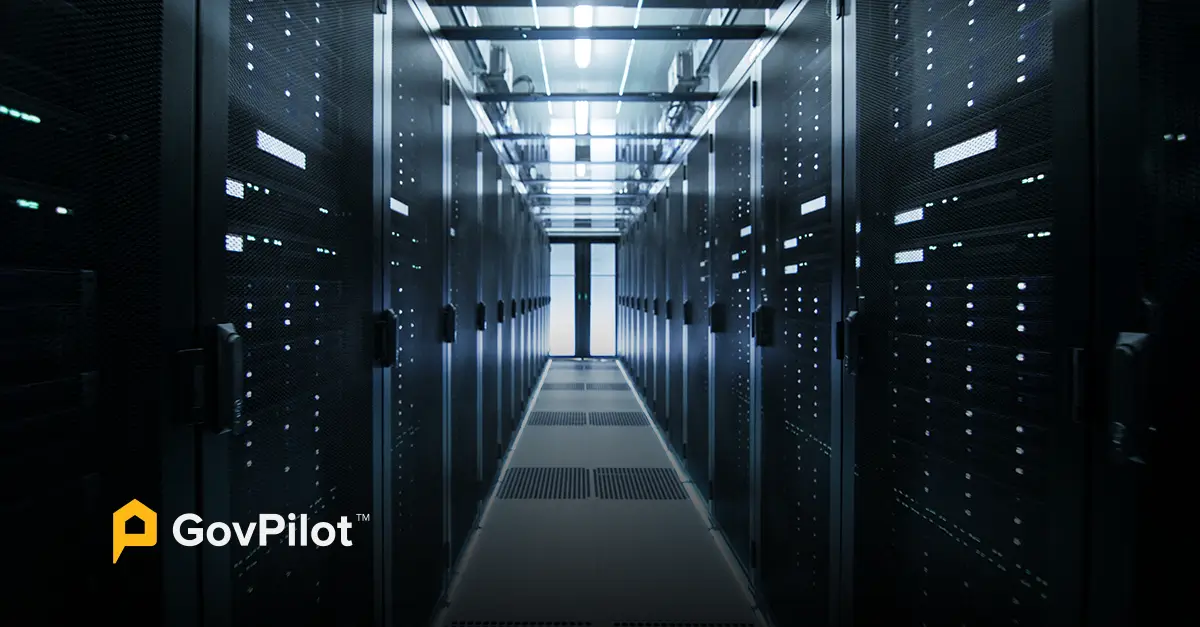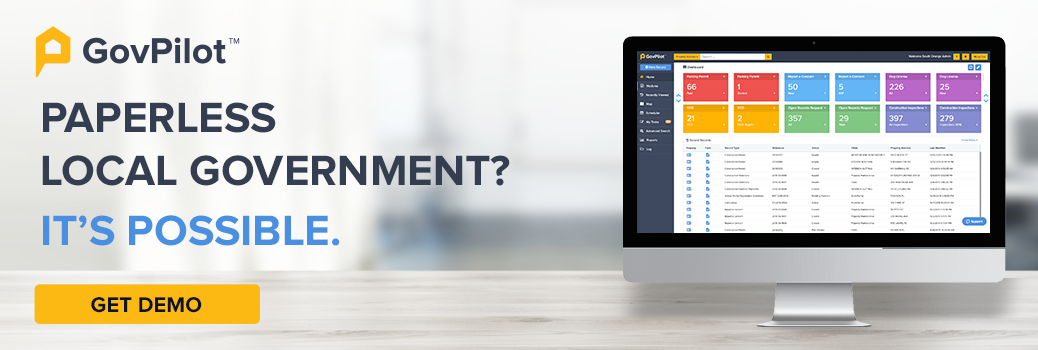Local governments have a lot of data to manage. From tracking annual budgets to maintaining resident information for government services, every employee in your agency relies on data.
That said, individual government staff can’t ensure the safety and security of this information all on their own. Government agencies must establish agency-wide processes and procedures to ensure data stays accessible and secure to anyone who needs it.
One approach to managing all this data is using the government cloud, a term you may have heard dropped in your professional circles. But despite this term’s popularity, you may not know precisely what it means – and you aren’t alone!
This post will help you understand the cloud and why so many local governments are turning to it for government data management. We’ll also dig into other popular data storage methods and why the cloud is the clear modern winner.
What is Government Data Storage?
Local government data storage involves managing and protecting critical information so municipal staff, board members, and residents can access it as needed. An efficient and effective storage methodology has the power to improve government communications and collaboration throughout the agency, helping ensure the best service delivery possible.
Due to the significance of this data, government agencies must take a holistic approach to data storage and security. Part of this comprehensive approach requires expecting the unexpected. Local governments must use systems that protect vital data from lost power, fires, natural disasters, cyber attacks, and more.
Where Governments Store Data
We’ve defined government data storage and explained why it’s so important. Now let’s dig into the most popular methods for storing data, including the pros and cons of each.
The cloud
When you hear anyone mention “the government cloud” or “the Govcloud,” they’re referring to a government’s use of a remote server, instead of servers located on-site. These remote servers are accessible using software and the internet and are typically managed by a third party.
You’ve likely used a cloud-based server in the past without necessarily realizing it. For example, Google Docs and SharePoint are both cloud-based collaborative software tools that enable you to simultaneously access the same data and documents as your colleagues.
|
Pros of using the cloud |
Cons of using the cloud |
|
|
On-site server
Relying on an on-site server for government data storage is another popular option, particularly for small-to-medium-sized municipalities. On-site servers store all government data at a secure location within a government building.
As a result, local governments must have adequate space to use this method of government data storage. Additionally, on-site government computer servers require more upkeep than paper-based processes. IT professionals within the organization must be proactive in regularly updating the servers, backing up data, and keeping premises secure.
|
Pros of On-Site Server |
Cons of On-Site Server |
|
|
Paper filing
Have you ever printed a piece of paper and saved it for later reference? Then congratulations! You’ve used one of the oldest and most common methods of government data storage: paper filing.
This data storage method has been in place long before the rise of computers and is as straightforward as it sounds. Whether you keep a haphazard pile of papers on your desk or use a more systematic filing system, you’re relying on paper-based data storage to keep important information at hand.
|
Pros of Paper-Based Data Storage |
Cons of Paper-Based Data Storage |
|
|
Consider the New York Local Government Management Plan to gain a deeper understanding of how the cloud can be incorporated in to government management.
The Clear Modern Winner: The Cloud
Now that you know about the different types of government data storage, you may be wondering: which is best for my municipality? There are a few straightforward reasons why using the cloud is the best modern approach to government data storage:
- The cloud is accessible from anywhere
- The cloud is less likely to be permanently compromised by data breaches than on-site government computer servers (learn more in our guide, Cloud vs In-House Servers for Local Governments)
- Your data is protected from local natural disasters
As public sector remote / hybrid work has grown increasingly prevalent, local governments have had to find ways to provide employees with access to all information required to do their jobs. The cloud enables staff to access this information without connecting to local servers through a VPN. This facilitates a more straightforward process for staff and reduces the need for IT professionals to continuously maintain the security and functionality of yet another network.
And because the majority of ransomware attacks target state and local governments, the cloud can also be beneficial for cybersecurity. Relying on government in-house systems requires regular maintenance and thoughtful cybersecurity strategies. IT staff must be rigorously proactive about routine backups and protecting information from hackers. In contrast, using cloud-based data storage means automatic backups and a reduced likelihood that your data will be held hostage in a targeted cyber attack.
Lastly, cloud-based data storage protects critical information from natural disasters your community may face. Because all of your data is stored off-site, you don’t need to worry about losing it should a fire or hurricane destroy your on-site servers. And as climate change continues to bring increasingly stronger storms and extreme weather, this is a comfort that shouldn’t be dismissed.
Here’s additional resources for preparing your community for natural disasters:
- Local Government Disaster Preparedness Guide
- Tornado Mitigation & Disaster Plan
- Wildfire Mitigation & Disaster Plan
- Flooding Mitigation & Disaster Plan
- Landslide Mitigation & Disaster Plan
How to Change Your Data Storage Approach
Fortunately, the process of changing your data storage approach is relatively straightforward. And if you’re using any of GovPilot’s government management software, you can lean on our onboarding support team for guidance in making the process as seamless as possible.
Switching from paper-based data storage
When switching from paper-based data storage to the cloud, you’ll first need to digitize all of your paper documents. But don’t simply grab the documents on your desk and start scanning! You likely don’t need to digitize every piece of paper sitting in City Hall. Because the process of digitizing can be arduous and time-consuming, it pays to be selective about what’s necessary to scan.
Once you’ve identified what you want to digitize, establish an organizational system for the data. This way, you know exactly where to save each digitized file in the cloud. Proper organization also reduces the likelihood of vital information getting lost while you move it to the cloud.
After you’ve digitized and determined how you’ll organize documents, the process is as easy as uploading them to the cloud-based storage service you’ve decided to use. Learn more in the guide to Going Paperless in Local Government.
Switching from an on-site server
Your job will be easier if you’re already managing digital documents with on-site servers. That’s because you can skip the time-consuming process of converting paper documents to digital files.
That said, you should still perform some housekeeping before transferring files to the cloud. Identify the data you plan to store in the cloud and establish an accompanying organizational system to ensure you know exactly where to find critical information once the transfer is complete.
Then, backup all data to your local server to ensure nothing gets lost in migration and begin transferring over to the cloud. If you’re using GovPilot’s government management software, we have a team that provides onboarding support to make this final step as seamless as possible.
Simplify Your Cloud Experience with GovPilot
Your local government agency is responsible for collecting, managing, and securing immense amounts of data. GovPilot’s operating system for local governments simplifies the cloud experience, so you never have to worry about your government data storage methods leading to critical information being lost or compromised.
If your government department is ready to eliminate the headaches involved in paper-based data storage and local server maintenance, book a free consultation today.
Government Data Storage FAQs
What is local government data storage?
Local government data storage involves storing and maintaining the large amounts of information required to provide community services. This data includes information like voting records, social services data (name, address, phone number), financial information, and more.
How do you ensure government data is safe and secure?
Given the increasing prevalence of cyber attacks on local and state governments, it’s critical that your department keeps its data safe and secure. You can accomplish this by developing a thorough cybersecurity strategy, including encrypting sensitive information, using two-factor authentication, deploying firewalls, requiring cybersecurity training for employees, among many other things. Additionally, storing information in the cloud can help keep your data safe and secure. Read on to learn more about Local Government Cybersecurity.
Why do local governments need to move away from paper filing?
There are multiple reasons governments should move away from paper filing. In addition to being less secure than other forms of data storage, paper filing also makes it difficult for remote employees to access the information they need exactly when they need it.
Additionally, it is more challenging to protect paper documents from natural disasters or emergencies, such as hurricanes, tornadoes, and fires. Should your local government suffer from one of these situations, you may lose information critical for government operations.
Read On:
- Mastering Local Government Analytics: Everything to Know
- Improving Your Local Government Website: UX, SEO, Navigation
- Continuity of Government: Government Procedures During a Crisis
- Strategic Planning in Local Governance: What to Consider
- Local Government Accountability: Operating a Truly Ethical Local Government
- Local Government IT Strategy: Improving IT Ticketing Workflows in Your Municipality.
- Government Data Breach Prevention: Preventing Data Loss & Leaks
- Modern Government Trends, Events, & Technology
- Best Software for Government Procurement
- How Can Local Governments Encourage Civic Engagement?
- Managing Invasive Species at the Local Level: What to Know
- Ultimate List of Local Government Departments
- How Can Local Governments Encourage Local Economic Development
- How to Regulate E-Bikes at the Local Level: Pros & Cons of Electric Bikes
- Local Government Water Utilities Strategy







